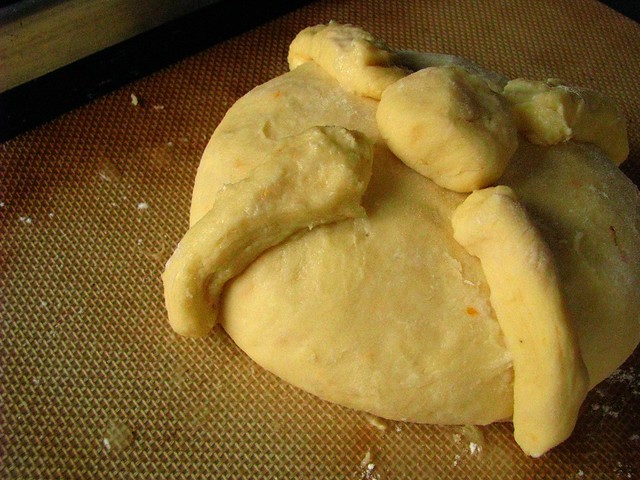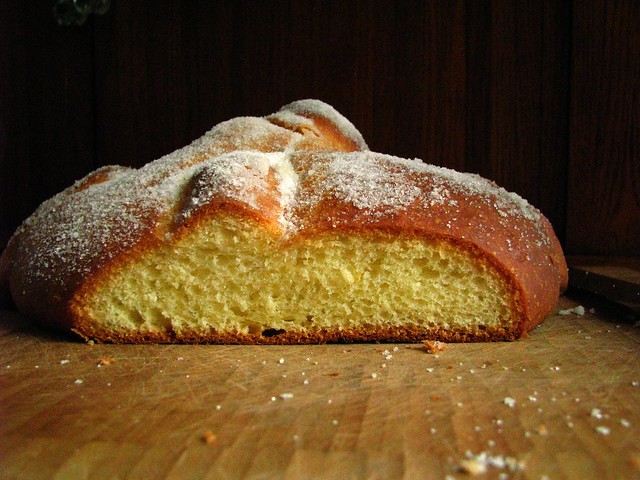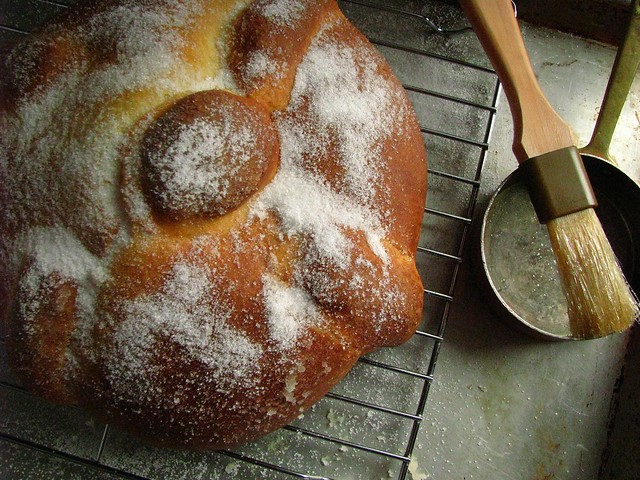
As you may already know, I've started writing a second blog for the community pages at Milwaukee Magazine. Yesterday, I wrote about cajeta - the Mexican caramel that is made from boiling down milk until it is rendered silky smooth and heartbreakingly brown. These first two days of November mark the celebrations of Dia de los Muertos, the days of the dead, and as I recounted yesterday, my family has not traditionally celebrated it.
My Mexican heritage is something somewhat buried inside me. Watered down by the generations of American citizenry, brought first to Texas then Chicago through my (maternal) Great Grandmother Carmen, a prize of my Mendez side is our love of sweets. My Mom has told me that my Great Grandmother used to love sweet sips of Pepsi, and all sweets really. "It's where we get it." she said, referring to our predisposition to sugar.
Personally I ebb and flow on the tide of desserts, all of them invade my thoughts and pulse through my culinary veins like the addiction I know it really is. In the past year, I have successfully cut back on sugary sweets, but I've given up trying to deny myself completely. Dessert is one of the great joys of my life, and if I lose a year or a tooth in the arms of this paramour, it will be worth it.
Personally I ebb and flow on the tide of desserts, all of them invade my thoughts and pulse through my culinary veins like the addiction I know it really is. In the past year, I have successfully cut back on sugary sweets, but I've given up trying to deny myself completely. Dessert is one of the great joys of my life, and if I lose a year or a tooth in the arms of this paramour, it will be worth it.
Having never celebrated Dia de los Muertos traditionally, I am a foreigner to the specialty sweets it brings with it. For my birthday, I had treated myself to a copy of Fany Gerson's My Sweet Mexico. Since, I've read it cover to cover, treasuring the photography as much as the descriptions of the recipes. She paints this holiday vividly, complete with with this enriched Pan de Muerto, flecked with orange peel and scented with orange water. I began it yesterday, unsure if it would succeed. The dough was unruly and sticky, but I stuck to Fany's insistence not to add additional flour unless absolutely necessary (after 15 minutes of stand mixer beating) and then no more than a small amount. My perseverance was worth it - and this is one of the loveliest, softest, gently sweet breads I've ever made.
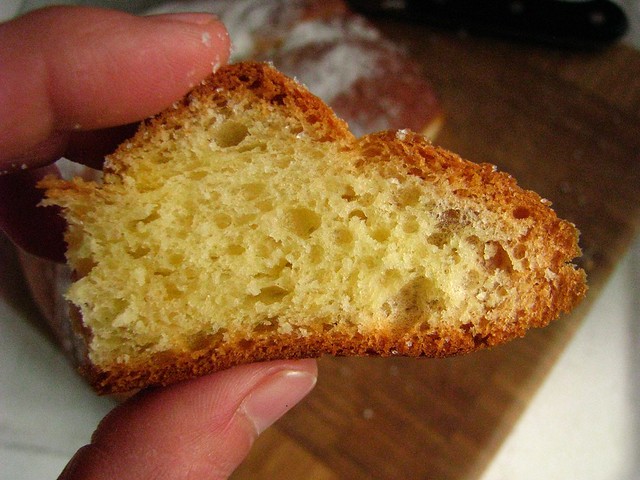
When reading through the recipe, I felt like I had tried something similar before. A quick consultation with my aged recipe box (the kind that holds the 3x5 cards that no one uses anymore) confirmed my familiarity: I had tried to make something called Portuguese Sweet Bread years ago without luck. I had gotten the recipe from my ex-boyfriend's bread-genius mother, and I remember her lemony little breads raising all over her kitchen one year around Christmastime. The amount of butter and egg involved create doubt in the most seasoned baker I think, but if you pay it no mind and continue as if you know exactly what you're doing, pillow soft egg bread is your reward.
There is a reason this is a special occasion bread. It's a bread meant to evoke memory and bring with it a specialness of an occasion. There are variations on flavors included in My Sweet Mexico, but I had to try the orangy flavor that was recommended. I secretly wondered if combining the yeast with orange flower water would kill it off, but it did not. It is simply decadent with a stick of butter (and more for the top) and 2 eggs, but worth every little nibble. I halved Fany's recipe to yield a single loaf. This is going to make some stellar toast tomorrow morning.
Remember to begin the day before baking.
Pan de Muerto (Fany Gerson)
yield 1 loaf
Dough:
Put the remaining flour (1 3/4 c.) in the bowl of a stand mixer fitted with the hook attachment and add sugar, salt, and orange zest. Mix for about 30 seconds. Add the eggs, the remaining milk and the yeast dough mixture. Mix on low speed until the dough comes together, then add the butter a little at a time in small pieces with the mixer running, increasing the speed to medium. (Here is where Fany begins to suggest that you should resist the urge to add more flour!) The dough will be sticky!
Continue beating for 10-15 minutes. (I let mine go 20 actually.) The dough should start to pull away from the sides of the bowl a little bit, but if it doesn't (like mine), add a small amount of flour, but no more than half of a 1/3 c. (I added a little handful.)
Lightly oil a large bowl, and place the dough inside. Cover well with plastic wrap, and let raise at warm room temperature until doubled in size 1-1 1/2 hours (mine took considerably longer, 3 hours, but my house is on the cool side). Lightly punch down the dough, gathering the sides up and flipping it over so that the seams are on the bottom. (I tried to do this like I did for making Deena's focaccia bread, leaving some air and being gentle.) Refrigerate for at least 4 hours or overnight.
When ready to continue, bring the dough out of the fridge and leave at room temp to warm up for an hour. Cut off a lime sized piece of dough to use for the "bones", and on a lightly floured surface, quickly shape the (still sticky) dough into a ball. Transfer to a parchment or silicone mat lined sheet and press down gently. Form bones out of the excess dough, 2 (that would intersect in the center as they make an "X" over the top) or 4 (small bone "snakes", like I did), and a little gumball-sized drop for the top. Let rest, covered with a clean towel, until doubled in size about 1 1/2 hours, maybe longer.
Towards the end of the rise, preheat oven to 350. Bake for 20 minutes, check browning (mine never got too brown, but if appearing to be browning too quickly, tent with aluminum foil). Continue baking for 10-20 more minutes until the bottom is browned (and temperature taken from the bottom is 190 degrees).
Remove from the pan to a wire rack and cool for a few minutes. Brush with melted butter, and immediately sprinkle with sugar evenly all over the top.
There is a reason this is a special occasion bread. It's a bread meant to evoke memory and bring with it a specialness of an occasion. There are variations on flavors included in My Sweet Mexico, but I had to try the orangy flavor that was recommended. I secretly wondered if combining the yeast with orange flower water would kill it off, but it did not. It is simply decadent with a stick of butter (and more for the top) and 2 eggs, but worth every little nibble. I halved Fany's recipe to yield a single loaf. This is going to make some stellar toast tomorrow morning.
Remember to begin the day before baking.
Pan de Muerto (Fany Gerson)
yield 1 loaf
Dough:
- 1 1/8 t. (a heaping teaspoon) active dry yeast
- 1 T. orange flower water
- 1/3 c. milk (whole or 2%)
- 2 c. bread flour
- 1/4 c. sugar
- 1/2 t. salt
- 1/2 t. grated orange zest (I keep some in the freezer)
- 2 eggs, lightly beaten
- 1/2 c. (1 stick) butter, room temperature
- 2 T. butter, melted
- 1/4 c. sugar (more or less)
Put the remaining flour (1 3/4 c.) in the bowl of a stand mixer fitted with the hook attachment and add sugar, salt, and orange zest. Mix for about 30 seconds. Add the eggs, the remaining milk and the yeast dough mixture. Mix on low speed until the dough comes together, then add the butter a little at a time in small pieces with the mixer running, increasing the speed to medium. (Here is where Fany begins to suggest that you should resist the urge to add more flour!) The dough will be sticky!
Continue beating for 10-15 minutes. (I let mine go 20 actually.) The dough should start to pull away from the sides of the bowl a little bit, but if it doesn't (like mine), add a small amount of flour, but no more than half of a 1/3 c. (I added a little handful.)
Lightly oil a large bowl, and place the dough inside. Cover well with plastic wrap, and let raise at warm room temperature until doubled in size 1-1 1/2 hours (mine took considerably longer, 3 hours, but my house is on the cool side). Lightly punch down the dough, gathering the sides up and flipping it over so that the seams are on the bottom. (I tried to do this like I did for making Deena's focaccia bread, leaving some air and being gentle.) Refrigerate for at least 4 hours or overnight.
When ready to continue, bring the dough out of the fridge and leave at room temp to warm up for an hour. Cut off a lime sized piece of dough to use for the "bones", and on a lightly floured surface, quickly shape the (still sticky) dough into a ball. Transfer to a parchment or silicone mat lined sheet and press down gently. Form bones out of the excess dough, 2 (that would intersect in the center as they make an "X" over the top) or 4 (small bone "snakes", like I did), and a little gumball-sized drop for the top. Let rest, covered with a clean towel, until doubled in size about 1 1/2 hours, maybe longer.
Towards the end of the rise, preheat oven to 350. Bake for 20 minutes, check browning (mine never got too brown, but if appearing to be browning too quickly, tent with aluminum foil). Continue baking for 10-20 more minutes until the bottom is browned (and temperature taken from the bottom is 190 degrees).
Remove from the pan to a wire rack and cool for a few minutes. Brush with melted butter, and immediately sprinkle with sugar evenly all over the top.
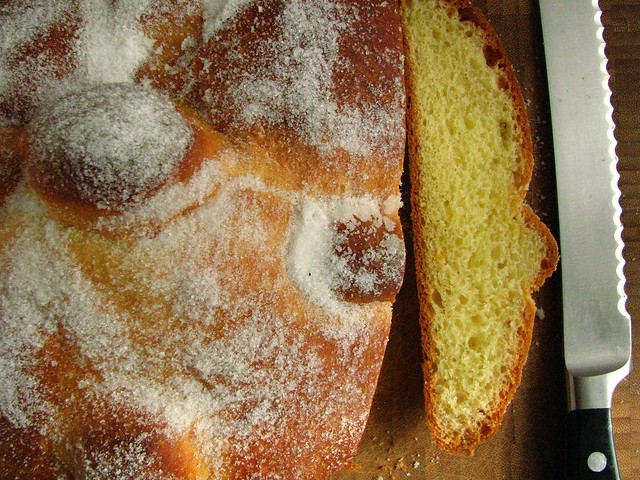
I know I shouldn't have been shocked that this bread was so soft, but I was. I was actually shocked that something so sticky could result in something so perfectly beautiful as well. After it cooled and I finally cut off the end to try, I was surprised that it reminded me of my my other (maternal) Great Grandmother Laura. She was from Poland, and made plenty of amazing sweets that I am lucky enough to remember eating as a child. Cheese crepes, blintzes really, and something I remember as a round doughnutty thing, Pączki. She likely treated the tops the same way, with melted butter and granulated sugar. In fact, the texture of this bread was nearly identical to what I remember as her soft bread-like buns with sugary crusts. This bread really did cause me to stir up all kinds of memories of loved ones, maybe the intent all along.
Reading farther in My Sweet Mexico I see that this same bread base is used for Three King's bread, Rosca de Reyes, which is studded with candied fruits and figurines on the 6 of January to celebrate the day that Jesus became known to the world. This in turn reminded me of the Stollen I made at Christmas for the first time last year, and the more I thought about it, I realized that the flavors were very similar.
This Pan de Muerto, however, is far more tender and delicate than it's German counterpart, one worth daydreaming over for a day or two until you can't take it any longer, and you have to celebrate something for the first time. Dia de los Muertos, these days of remembering, have been very special for me. Now, I'll have taste memories to go along with it and fondly revisit. ¡Necesito recordar mi herencia mexicana! Through a few of the celebratory foodstuffs, I can do just that.
This post has been Yeastspotted.
Reading farther in My Sweet Mexico I see that this same bread base is used for Three King's bread, Rosca de Reyes, which is studded with candied fruits and figurines on the 6 of January to celebrate the day that Jesus became known to the world. This in turn reminded me of the Stollen I made at Christmas for the first time last year, and the more I thought about it, I realized that the flavors were very similar.
This Pan de Muerto, however, is far more tender and delicate than it's German counterpart, one worth daydreaming over for a day or two until you can't take it any longer, and you have to celebrate something for the first time. Dia de los Muertos, these days of remembering, have been very special for me. Now, I'll have taste memories to go along with it and fondly revisit. ¡Necesito recordar mi herencia mexicana! Through a few of the celebratory foodstuffs, I can do just that.
This post has been Yeastspotted.

